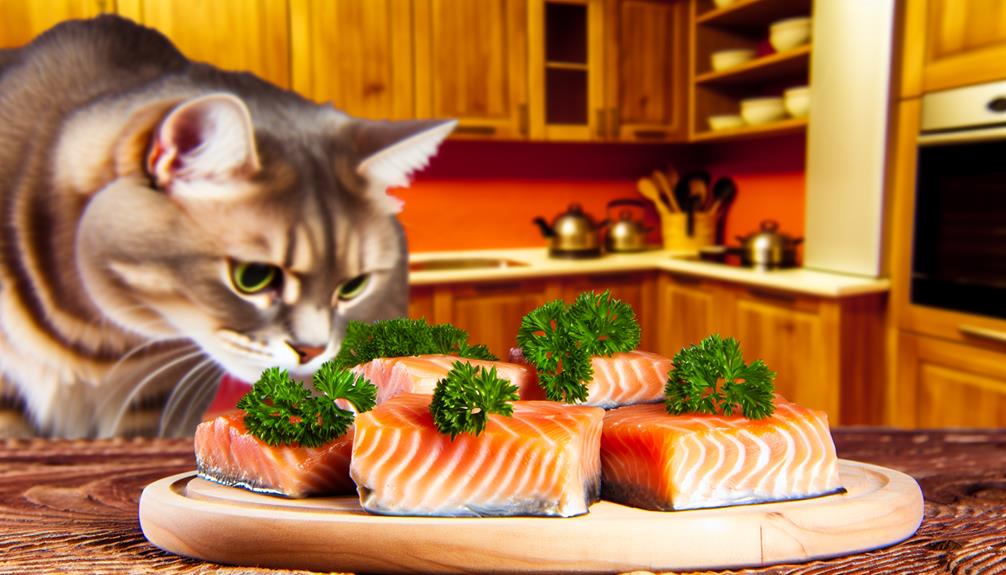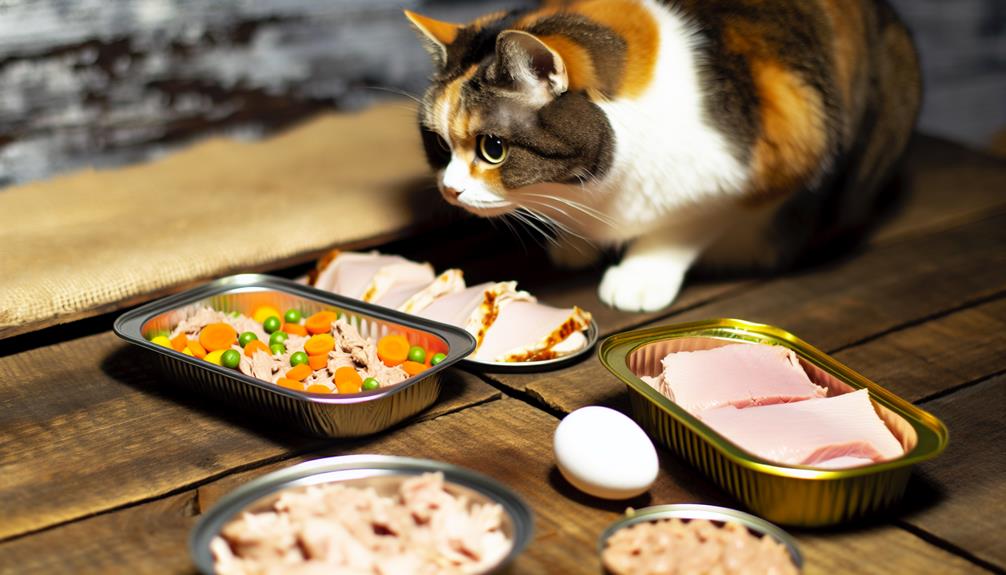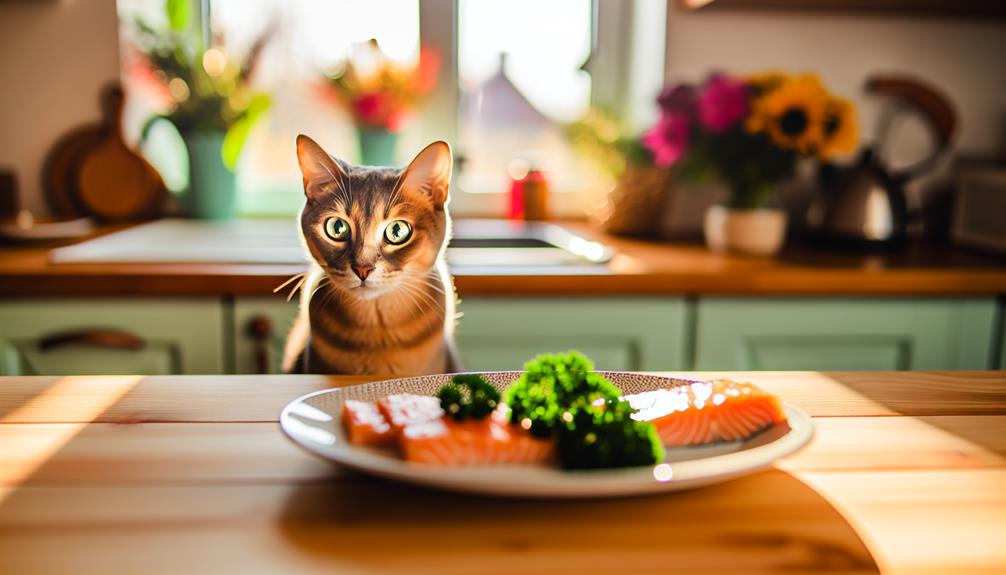Did you know that salmon can actually be a beneficial treat for your feline friend? While it's packed with omega-3 fatty acids and high-quality protein, there are some important things you need to know before sharing your dinner with your cat. For instance, serving it cooked is essential to avoid any harmful bacteria, and removing all bones is a must to prevent choking. But, should salmon be a regular part of your cat's diet, or just an occasional indulgence? Understanding the proper portion sizes and frequency is key, and there are alternatives you might want to take into account.
Nutritional Benefits of Salmon
One key nutritional benefit of salmon for cats is its high omega-3 fatty acid content. Omega-3 fatty acids, particularly EPA (eicosapentaenoic acid) and DHA (docosahexaenoic acid), are critical for feline health. These important fatty acids support various physiological functions including inflammation regulation, cardiovascular health, and maintaining a healthy coat and skin.
Salmon nutrients extend beyond just omega-3s. This fish is also a rich source of high-quality protein, which is essential for muscle maintenance and repair in cats. The amino acid profile in salmon is well-suited to meet the biological needs of felines, who are obligate carnivores and require animal-based proteins to thrive.
Additionally, salmon provides important vitamins and minerals such as Vitamin B12, Vitamin D, and selenium. Vitamin B12 plays a significant role in maintaining neurological function and forming red blood cells. Vitamin D, while synthesized through sun exposure, can be supplemented through diet to aid in calcium absorption and bone health. Selenium, an antioxidant, assists in preventing cellular damage from free radicals.
Omega fatty acids in salmon also contribute to cognitive function and have been shown to support brain health in aging cats. The anti-inflammatory properties of these fatty acids can help alleviate symptoms in cats suffering from arthritis or other inflammatory conditions.
When considering the inclusion of salmon in your cat's diet, it's important to verify the fish is properly cooked to eliminate any potential pathogens. Overall, the diverse array of salmon nutrients makes it a valuable addition to a balanced feline diet, promoting overall health and well-being.
Risks of Feeding Salmon to Cats
While salmon offers numerous nutritional benefits for cats, it's also important to contemplate the potential risks associated with feeding this fish. One of the primary concerns is the possibility of allergic reactions. Cats, like humans, can develop food allergies, and fish is a known allergen. Symptoms can range from mild gastrointestinal disturbances to severe skin conditions, including itching, redness, and hair loss.
Another significant risk is mercury exposure. Salmon, especially those caught in polluted waters, can accumulate mercury, which is toxic to cats. Chronic mercury exposure can lead to neurological symptoms, such as tremors and cognitive dysfunction, as well as kidney damage.
Moreover, raw or undercooked salmon can harbor parasites and bacteria, such as Salmonella and Listeria, posing a severe health risk to your feline friend. Cooking the fish correctly can mitigate these risks but does not eliminate the potential for allergic reactions or mercury exposure.
Here's a quick overview to help you understand the risks better:
| Risk | Description | Symptoms/Consequences |
|---|---|---|
| Allergic Reactions | Potential for adverse immune responses to fish proteins | Gastrointestinal issues, skin conditions |
| Mercury Exposure | Accumulation of toxic mercury in the fish, particularly in polluted waters | Neurological symptoms, kidney damage |
| Parasites/Bacteria | Presence of harmful organisms in raw or undercooked salmon | Gastrointestinal illness, severe infections |
How to Prepare Salmon for Cats

Preparing salmon for your cat requires careful attention to both cooking methods and serving portions to guarantee the safety and nutritional benefits of the meal. First, it's vital to avoid raw salmon, as it can contain harmful bacteria and parasites. Cooking methods that are safe and beneficial include baking, poaching, or steaming the salmon without any added salt, spices, or oils.
When preparing the salmon, follow these guidelines:
- Remove all bones: Even the smallest bone can pose a choking hazard or cause internal injury to your cat.
- Cook thoroughly: Confirm the salmon is cooked through, reaching an internal temperature of at least 145°F (63°C), to eliminate any potential pathogens.
- Avoid seasoning: Cats have different dietary needs than humans, and ingredients like garlic, onions, and excessive salt can be toxic to them.
- Serve in small, manageable pieces: After cooking, flake the salmon into bite-sized portions to make it easier for your cat to eat and digest.
These cooking methods and serving suggestions guarantee that your cat receives the nutritional benefits of salmon without the associated risks. Salmon is rich in omega-3 fatty acids, which can support your cat's skin, coat, and overall health, but it's important to serve it properly.
Frequency and Portion Sizes
Determining the appropriate frequency and portion sizes for feeding salmon to your cat is fundamental for guaranteeing a balanced diet and preventing potential health issues. Cats require a diet primarily composed of animal proteins and fats, but it's important to moderate their intake of any single food item, including salmon.
In terms of feeding frequency, salmon should be viewed as an occasional treat rather than a staple in your cat's diet. Experts recommend offering salmon no more than once or twice a week. This limited frequency helps mitigate the risks associated with excessive intake of oily fish, such as mercury accumulation and potential nutrient imbalances.
When determining portion guidelines, it's critical to assess your cat's overall dietary needs, weight, and activity level. A general recommendation is to offer no more than 10% of your cat's total weekly caloric intake from treats, including salmon. For an average-sized adult cat weighing around 10 pounds, this typically translates to approximately 1-2 tablespoons of cooked salmon per serving. Always make sure the salmon is boneless, skinless, and thoroughly cooked to avoid the risk of bacterial infections and bone splinters.
Monitoring your cat's response to salmon is also fundamental. If you observe any signs of gastrointestinal upset or allergic reactions, such as vomiting, diarrhea, or itching, discontinue the salmon and consult your veterinarian. By adhering to these feeding frequency and portion guidelines, you can safely incorporate salmon into your cat's diet, offering variety and nutritional benefits without compromising their health.
Alternatives to Salmon

Often, it's advantageous to explore alternatives to salmon when considering the most balanced and nutritious diet for your cat. While salmon is rich in omega-3 fatty acids and protein, diversifying your cat's diet can prevent nutritional imbalances and reduce the risk of food sensitivities. Various other fish and protein sources can serve as excellent tuna alternatives and sardine options.
Here are some prime alternatives:
- Tuna: Tuna is another popular choice, but it's important to moderate its consumption due to potential mercury content and lack of essential nutrients when relied upon exclusively.
- Sardines: Sardines offer a rich source of omega-3 fatty acids and calcium, making them a great option. Be sure to choose those packed in water without added salt or oil.
- Whitefish: Whitefish such as cod or haddock are low-fat options that are also gentle on your cat's digestive system, providing a good balance of nutrients.
- Chicken: For a non-fish option, lean poultry like chicken is an excellent source of protein and can be easily digested. Confirm it's cooked plain without any seasoning or additives.
Clinical studies have shown that a varied diet can help in maintaining a favorable balance of nutrients and avoiding the pitfalls associated with a single-source diet. By incorporating these tuna alternatives and sardine options, you can guarantee your cat receives a well-rounded intake of essential nutrients. Always consult with a veterinarian before making significant changes to your cat's diet to tailor the best nutritional plan suited to their specific needs and health conditions.
Conclusion
So, should you serve your feline overlord a delectable salmon treat? Absolutely, but don't get carried away. Remember, salmon should be cooked, bone-free, and served in meager portions—1-2 tablespoons for a 10-pound cat, once or twice a week. Consult your vet because, let's face it, no one wants a cat with a fishy problem. After all, we wouldn't want Mr. Whiskers to turn into a salmon addict, would we? Moderation is key, dear cat servant.
